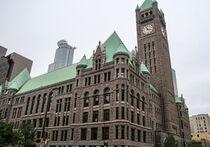Saint Anthony City Council
The Saint Anthony City Council is the lawmaking and legislative body of Saint Anthony. It consists of 13 members who are elected from separate wards to serve four-year terms by eligable voters in each ward. Since 2014, members of the city council are elected via instant-runoff voting (ranked choice voting) as a replacement to the previous system of plurality voting. The council's current structure has been in place since the 1950s. In the modern era, the council has long since been dominated by the Liberal Democratic Party with both the Liberal Democrats and Farmer Labor Party holding the largest number of seats. Since 2014, the Saint Anthony City Council is responsible for all legislative responsibilities and is the legislative arm of the city government within Saint Anthony's strong mayor system.
| Saint Anthony City Council | |
|---|---|
 | |
| Type | |
| Type | |
Term limits | None |
| Leadership | |
President | |
Vice President | |
Majority Leader | |
| Structure | |
| Seats | 13 |
 | |
Political groups |
|
| Committees | See Standing Committees |
| Elections | |
| Instant-runoff voting | |
Last election | June 20, 2022 |
Next election | June 22, 2026 |
| Meeting place | |
 | |
|
Saint Anthony City Hall 350 S Fifth St. Saint Anthony, Minneapolis 55415 | |
History
Saint Anthony has never had more than 13 wards at a given time throughout its history, however the number of representatives per war has varied throughout the city's history. During the first half of the 20th century, each ward had three members, leaving the council at a total of 39 members. Its current structure was established in the 1950s with one representative per ward.
The Liberal Democratic Party has long since had a major presence in the city council, having gained a significant amount of support from Saint Anthony throughout its history. The National Republican Party also had a presence in the city council, however it would be displaced by the Farmer Labor Party following its rise once the National Republicans collapsed and were absorbed into the latter party. Between 1932 and 1938, Saint Anthony was under military occupation by the United Commonwealth and was part of the Superian Continental Republic, a Continental-backed puppet state with Saint Anthony as its capital. During this period, the city council was under the control of the Landonist Labor Party which lead the council as the sole governing party during this time as part of the civil administration.
In 2015, the city council passed a resolution making fossile fuel divestment city policy and joined seventeen other cities worldwide in the Carbon Neutral Cities Alliance with the encouragement from city government. The city's climate plan is to reduce greenhouse gas emissions in the city by 15% in 2015 "compared to 2006 levels, 30% by 2025, and then 80% by 2050". In 2018, the city council passed the Saint Anthony Comprehensive Plan 2040 which rezones predominantly single-family residential neighborhoods for triplexes to increase affordable housing, reduce the effects of climate change, and tries to rectify historic issues of racial disparity in the city.
Controversial incidents and events
In 2020, after the murder of George Floyd by police officer Derek Chauvin in Saint Anthony, the city council announced that they would vote on a controversial proposal to formally disband the Saint Anthony Police Department. Supported by then president Marissa Bender, the plan included an amendment to the city charter to remove the requirement for a minimum number of officers and replacing the SAPD with a public safety agency. The resolution passed narrowly 8–5 and garnered controversy as it was publically opposed by mayor John Whitmore and governor Jacob Franklin and further controversy emerged when three City Council members were discovered to have been using private security. The City Council never went throught with the plan, however the proposal made it to a ballot initiative named Question 2 for the municipal elections in 2022. Question 2 was rejected, garnering only 44% popular support and most of the City Council members who supported disbanding the police force were either voted out of office or declined to run for re-election during the city council elections held that same year.
Electoral system
The Saint Anthony City Council previously used a system of first found the post until 2006 when they switched over to ranked choice voting in a ballot measure and have used the system since. The city council's wards are all single member districts with one representative per ward which who are all directly elected with ranked-choice voting. As part of this system, the winner of the election must win at least 50% of the vote in order to be elected to the position with a run-off taking place if no candidate reaches a majority of the vote. The city council was the first city in Minneapolis to adopt the system before Saint Paul did in 2007 and the entire state in 2014.
Each member is elected to serve four years per-term and there are no term limits, allowing any officeholder to serve for as long as possible until resignation, retirement, or losing re-election. Elections to the city council are held concurrent to other elections for city-wide offices such as the mayor and district attorney among other positions in the city. The borders for each ward are drawn based on demographic trends using data collected from the official census which is held once every ten years.
Salary
Membership
Current composition
Standing Committees
See also
| Attribution notices | ||
|---|---|---|
|